
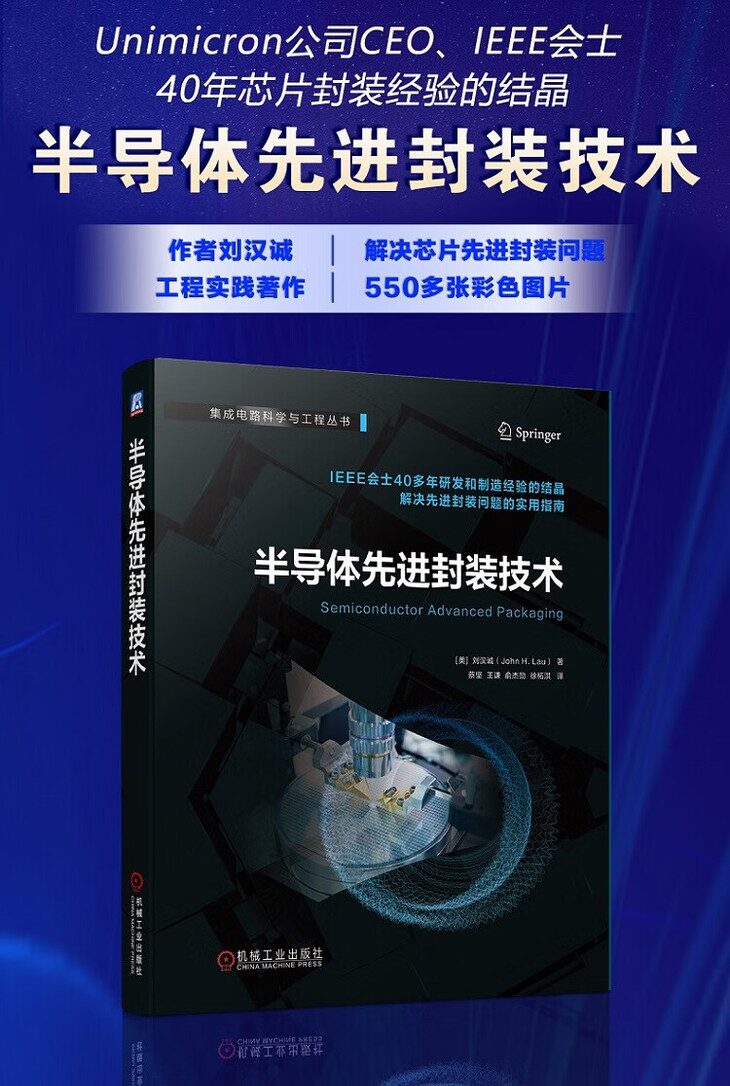
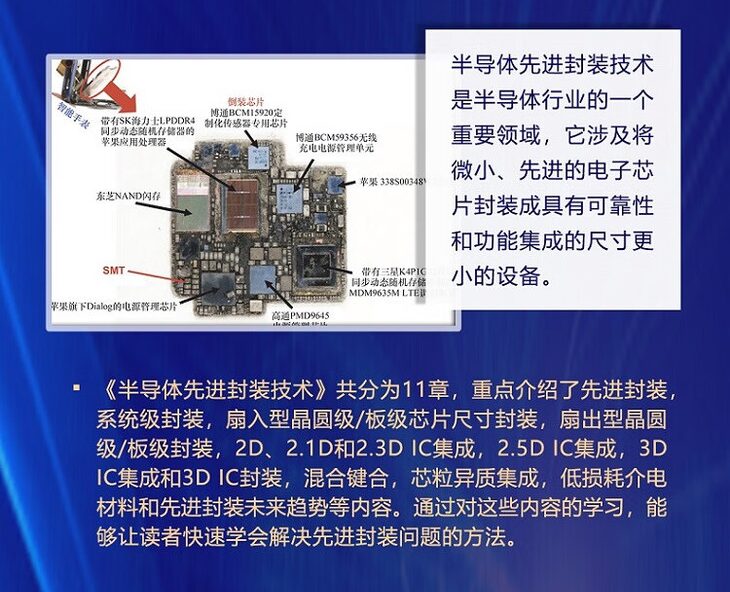
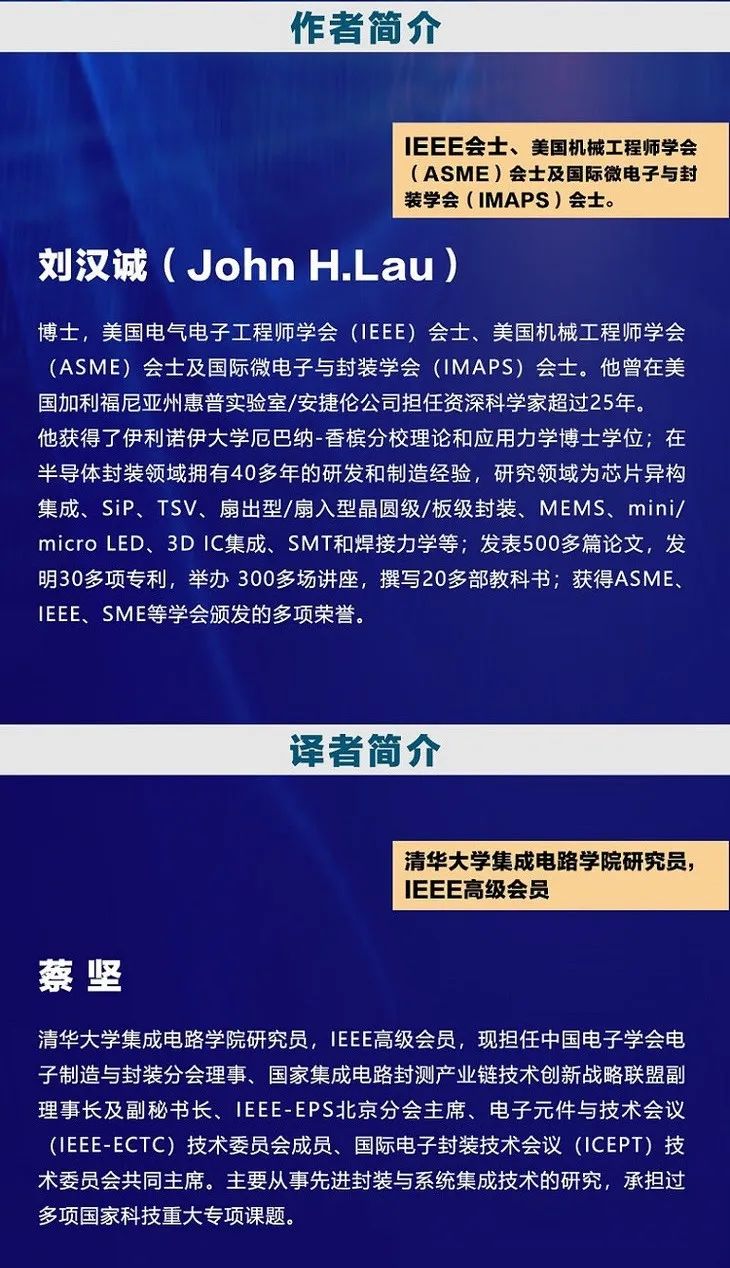
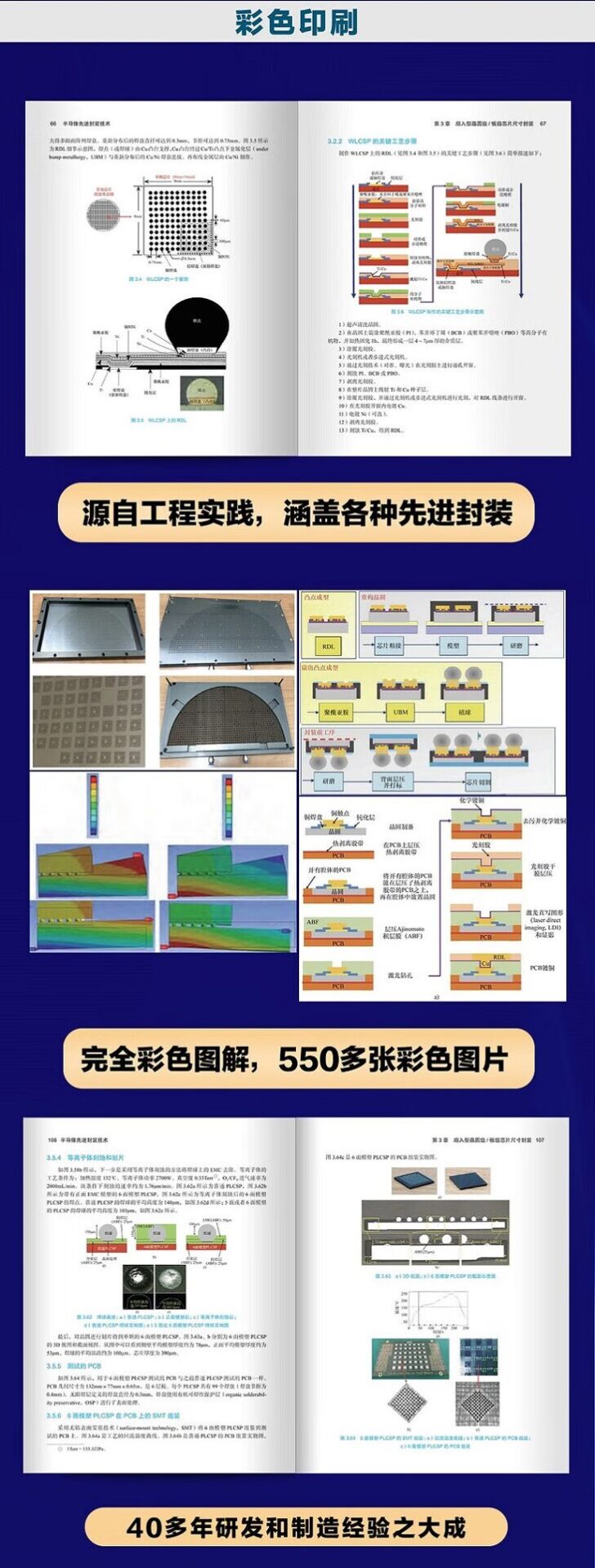
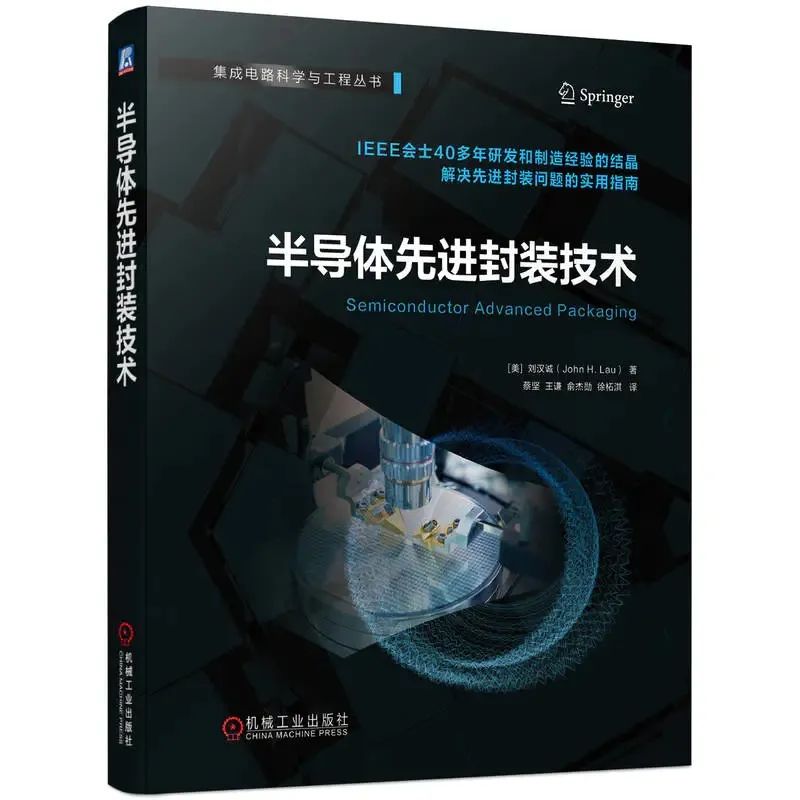
Click the image to learn more
Preface
Chapter 1 Advanced Packaging 1
1.1 Introduction 1
1.2 Applications of Semiconductors 1
1.3 Driving Forces of System Technologies 1
1.3.1 AI 1
1.3.2 5G 2
1.4 Overview of Advanced Packaging 3
1.4.1 Types of Advanced Packaging 3
1.4.2 Levels of Advanced Packaging 3
1.5 2D Fan-out (First on Die) IC Integration 5
1.6 2D Flip-chip IC Integration 5
1.7 PoP, SiP, and Heterogeneous Integration 6
1.8 2D Fan-out (Last on Die) IC Integration 8
1.9 2.1D Flip-chip IC Integration 8
1.10 2.1D with Interconnect Bridge Flip-chip IC Integration 9
1.11 2.1D with Interconnect Bridge Fan-out IC Integration 9
1.12 2.3D Fan-out (First on Die) IC Integration 10
1.13 2.3D Flip-chip IC Integration 10
1.14 2.3D Fan-out (Last on Die) IC Integration 11
1.15 2.5D (C4 Bump) IC Integration 12
1.16 2.5D (C2 Bump) IC Integration 12
1.17 Micro Bump 3D IC Integration 13
1.18 Micro Bump Chiplet 3D IC Integration 14
1.19 Bump-less 3D IC Integration 14
1.20 Bump-less Chiplet 3D IC Integration 15
1.21 Summary and Recommendations 15
References 16
Chapter 2 System-in-Package 22
2.1 Introduction 22
2.2 System-on-Chip 22
2.3 Overview of SiP 23
2.4 Purpose of Using SiP 23
2.5 Practical Applications of SiP 23
2.6 Examples of SiP 24
2.7 SMT 25
2.7.1 PCB 26
2.7.2 SMD 28
2.7.3 Solder Paste 29
2.7.4 Stencil Printing Solder Paste and Automated Optical Inspection 30
2.7.5 Picking and Placing SMD 32
2.7.6 AOI of SMD on PCB 33
2.7.7 SMT Solder Reflow 33
2.7.8 Defect AOI and X-ray Inspection 34
2.7.9 Rework 35
2.7.10 Summary and Recommendations 36
2.8 Flip-chip Technology 36
2.8.1 Wafer Bump Forming Technology Based on Stencil Printing 37
2.8.2 C4 Wafer Bump Forming Technology 38
2.8.3 C2 Wafer Bump Forming Technology 40
2.8.4 Flip-chip Assembly – C4/C2 Bump Batch Reflow (CUF) 40
2.8.5 Underfill to Enhance Reliability 42
2.8.6 Flip-chip Assembly – C4/C2 Bump Low Pressure Thermal Compression Bonding (CUF) 44
2.8.7 Flip-chip Assembly – C2 Bump High Pressure Thermal Compression Bonding (NCP) 45
2.8.8 Flip-chip Assembly – C2 Bump High Pressure Thermal Compression Bonding (NCF) 45
2.8.9 An Advanced Flip-chip Assembly – C2 Bump Liquid Phase Contact Thermal Compression Bonding 47
2.8.10 Summary and Recommendations 53
References 54
Chapter 3 Fan-in Wafer-Level/Board-Level Chip Size Packaging 63
3.1 Introduction 63
3.2 Fan-in Wafer-Level Chip Size Packaging (WLCSP) 65
3.2.1 Packaging Structure 65
3.2.2 Key Process Steps of WLCSP 67
3.2.3 Assembly of WLCSP on PCB 68
3.2.4 Thermal Simulation of WLCSP Assembly on PCB 68
3.2.5 Summary and Recommendations 74
3.3 Fan-in Board-Level Chip Size Packaging (PLCSP) 75
3.3.1 Test Chip 75
3.3.2 Test Package Body 76
3.3.3 PLCSP Process Flow 77
3.3.4 PLCSP PCB Assembly 83
3.3.5 Drop Test of PLCSP PCB Assembly 84
3.3.6 Thermal Cycling Test of PLCSP PCB Assembly 86
3.3.7 Thermal Cycling Simulation of PLCSP PCB Assembly 92
3.3.8 Summary and Recommendations 95
3.4 Six-Sided Molded Wafer-Level Chip Size Packaging 96
3.4.1 StarTech’s eWLCSP 97
3.4.2 United Technology’s WLCSP 97
3.4.3 SPIL’s mWLCSP 97
3.4.4 Huatian Technology’s WLCSP 99
3.4.5 SPIL and MediaTek’s mWLCSP 99
3.4.6 Summary and Recommendations 102
3.5 Six-Sided Molded Board-Level Chip Size Packaging 102
3.5.1 Structure of Six-Sided Molded PLCSP 102
3.5.2 Front Wafer Cutting and EMC Molding 104
3.5.3 Back Thinning and Wafer Back Molding 104
3.5.4 Plasma Etching and Dicing 106
3.5.5 Test PCB 106
3.5.6 SMT Assembly of Six-Sided Molded PLCSP on PCB 106
3.5.7 Thermal Cycling Test of Six-Sided Molded PLCSP 108
3.5.8 Thermal Cycling Simulation of Six-Sided Molded PLCSP PCB Assembly 111
3.5.9 Summary and Recommendations 115
References 115
Chapter 4 Fan-out Wafer-Level/Board-Level Packaging 124
4.1 Introduction 124
4.2 Fan-out (First on Die and Face Down) Wafer-Level Packaging (FOWLP) 125
4.2.1 Test Chip 125
4.2.2 Test Package Body 126
4.2.3 Traditional First on Die (Face Down) Wafer-Level Process 127
4.2.4 New Processes for Heterogeneous Integration Packaging 128
4.2.5 Dry Film EMC Lamination 128
4.2.6 Temporary Bonding to Another Glass Support Plate 128
4.2.7 Re-routing Layer 130
4.2.8 Solder Ball Placement 131
4.2.9 Final Debonding 131
4.2.10 PCB Assembly 134
4.2.11 Reliability of Heterogeneous Integration (Drop Test) 135
4.2.12 Summary and Recommendations 137
4.3 Fan-out (First on Die and Face Down) Board-Level Packaging (FOPLP) 137
4.3.1 Heterogeneous Integration of Test Package Body 138
4.3.2 A New Uni-SIP Process 140
4.3.3 Dry Film Lamination of ECM Panel 140
4.3.4 Lamination of Uni-SIP Structure 141
4.3.5 New ABF Lamination, Laser Drilling, and De-bonding Residue 141
4.3.6 Laser Direct Writing Patterns and PCB Copper Plating 144
4.3.7 Summary and Recommendations 145
4.4 Fan-out (First on Die and Face Up) Wafer-Level Packaging 146
4.4.1 Test Chip 146
4.4.2 Process Flow 146
4.5 Fan-out (First on Die and Face Up) Board-Level Packaging 148
4.5.1 Packaging Structure 148
4.5.2 Process Flow 148
4.6 Fan-out (Last on Die or First RDL) Wafer-Level Packaging 150
4.6.1 IME’s First RDL FOWLP 151
4.6.2 Test Structure 151
4.6.3 Key Process Steps of First RDL 152
4.6.4 PCB Assembly of First RDL FOWLP 154
4.7 Fan-out (Last on Die or First RDL) Board-Level Packaging 154
4.7.1 Test Chip 154
4.7.2 Test Package Body 154
4.7.3 Heterogeneous Integration for First RDL Board-Level Packaging 157
4.7.4 Production of RDL Substrate 157
4.7.5 Wafer Bump Forming 160
4.7.6 Chip-Substrate Bonding 160
4.7.7 Underfill and EMC Molding 162
4.7.8 Panel/Strip Transfer 163
4.7.9 Solder Mask Opening and Surface Treatment 163
4.7.10 Solder Ball Placement, Debonding, and Strip Cutting 163
4.7.11 PCB Assembly of First RDL Board-Level Packaging 165
4.7.12 Drop Test Results and Failure Analysis 165
4.7.13 Thermal Cycling Test Results and Failure Analysis 169
4.7.14 Thermal Cycling Simulation 174
4.7.15 Summary and Recommendations 175
4.8 Mini-LED RGB Display Fan-out Board-Level Packaging 176
4.8.1 Test Mini-LED 177
4.8.2 SMD Packaging of Test Mini-LED RGB Display 178
4.8.3 RDL and Mini-LED RGB SMD Manufacturing 179
4.8.4 PCB Assembly 182
4.8.5 Drop Test 185
4.8.6 Thermal Cycling Simulation 185
4.8.7 Summary and Recommendations 191
References 191
Chapter 5 2D, 2.1D, and 2.3D IC Integration 200
5.1 Introduction 200
5.2 2D IC Integration – Wire Bonding 200
5.3 2D IC Integration – Flip-chip 201
5.4 2D IC Integration – Wire Bonding and Flip-chip 201
5.5 RDL 202
5.5.1 Organic RDL 202
5.5.2 Inorganic RDL 202
5.5.3 Hybrid RDL 202
5.6 2D IC Integration – Fan-out (First on Die) 203
5.6.1 HTC’s Desire 606W 203
5.6.2 Four Chip Heterogeneous Integration 203
5.7 2D IC Integration – Fan-out (Last on Die) 205
5.7.1 IME’s Last on Die Fan-out Packaging 205
5.7.2 Amkor’s SWIFT 206
5.7.3 Amkor’s SLIM 207
5.7.4 SPIL’s Hybrid RDL Fan-out 208
5.7.5 Unimicron’s Fan-out Last on Die Process 209
5.8 2.1D IC Integration 210
5.8.1 Shinko’s i-THOP 210
5.8.2 Hitachi’s 2.1D Organic Interposer 212
5.8.3 ASE’s 2.1D Organic Interposer 212
5.8.4 SPIL’s 2.1D Organic Interposer 213
5.8.5 JCET’s uFOS 215
5.8.6 Intel’s EMIB 216
5.8.7 Applied Materials’ Interconnect Bridge 217
5.8.8 TSMC’s LSI 217
5.9 2.3D IC Integration 217
5.10 2.3D IC Integration Using SAP/PCB Method 218
5.10.1 Shinko’s Coreless Organic Interposer 218
5.10.2 Cisco’s Organic Interposer 219
5.11 2.3D IC Integration Using Fan-out (First on Die) Technology 220
5.11.1 StarTech’s 2.3D eWLB 220
5.11.2 MediaTek’s Fan-out (First on Die) Technology 222
5.11.3 ASE’s FOCoS (First on Die) 223
5.11.4 TSMC’s InFO_oS and InFO_MS 224
5.12 2.3D IC Integration Using Fan-out (Last on Die) Technology 225
5.12.1 SPIL’s NTI 225
5.12.2 Samsung’s No-Silicon RDL Interposer 225
5.12.3 ASE’s FOCoS (Last on Die) 228
5.12.4 TSMC’s Multi-layer RDL Interposer 229
5.12.5 Shinko’s 2.3D Organic Interposer 229
5.12.6 Unimicron’s 2.3D RDL Interposer 232
5.13 Summary and Recommendations 247
References 247
Chapter 6 2.5D IC Integration 251
6.1 Introduction 251
6.2 Leti’s SoW Technology (Origin of 2.5D IC Integration Technology) 251
6.3 IME’s 2.5D IC Integration Technology 252
6.3.1 2.5D IC Integration’s Three-Dimensional Nonlinear Local and Global Analysis 252
6.3.2 2.5D IC Integration Technology for Electrical and Fluid Interconnections 254
6.3.3 Double-Sided Stacked Passive TSV Interposer 256
6.3.4 TSV Interposer as Stress (Reliability) Buffer 257
6.4 Hong Kong University of Science and Technology’s Double-Sided Integrated Chip TSV Interposer Technology 258
6.5 Taiwan’s Industrial Technology Research Institute’s 2.5D IC Integration 259
6.5.1 Thermal Management of Double-Sided Integrated Chip TSV Interposer 259
6.5.2 TSV Interposer Application in LED with Embedded Fluid Microchannels 260
6.5.3 TSV Interposer Integrated with System-on-Chip and Memory Cube 262
6.5.4 Semi-Embedded TSV Interposer 263
6.5.5 Double-Sided Bonded Chip TSV Interposer 264
6.5.6 Double-Sided Integrated Chip TSV Interposer 266
6.5.7 TSH Interposer 268
6.6 TSMC’s CoWoS Technology 270
6.7 Xilinx/TSMC’s 2.5D IC Integration 270
6.8 Altera/TSMC’s 2.5D IC Integration 273
6.9 AMD/UMC’s 2.5D IC Integration 273
6.10 NVIDIA/TSMC’s 2.5D IC Integration 274
6.11 TSMC CoWoS Roadmap 275
6.12 Recent Advances in 2.5D IC Integration 276
6.12.1 TSMC’s CoWoS with Deep Trench Capacitors 276
6.12.2 IME’s Non-Destructive Failure Location Method for 2.5D IC Integration 277
6.12.3 Fraunhofer’s Optoelectronic Interposer 277
6.12.4 Dai Nippon/AGC’s Glass Interposer 278
6.12.5 Fujitsu’s Multi-layer Glass Interposer 280
6.13 Summary and Recommendations 280
References 281
Chapter 7 3D IC Integration and 3D IC Packaging 287
7.1 Introduction 287
7.2 3D IC Packaging 287
7.2.1 3D IC Packaging – Wire Bonded Memory Chip Stacking 287
7.2.2 3D IC Packaging – Face-to-Face Bonding with Wire Bonding to Substrate 291
7.2.3 3D IC Packaging – Back-to-Back Bonding with Wire Bonding to Substrate 292
7.2.4 3D IC Packaging – Face-to-Face Bonding with Bumps/Solder Balls to Substrate 293
7.2.5 3D IC Packaging – Face-to-Back 296
7.2.6 3D IC Packaging – Embedded Chips in SiP (Face-to-Face) 296
7.2.7 3D IC Packaging – PoP Using Flip-chip Technology 298
7.2.8 3D IC Packaging – PoP Using Fan-out Technology 300
7.2.9 Summary and Recommendations 303
7.3 3D IC Integration 303
7.3.1 3D IC Integration – HBM Standards 303
7.3.2 3D IC Integration – HBM Assembly 305
7.3.3 3D IC Integration – Chip Stacking Using TSV 307
7.3.4 3D IC Integration – Bump-less Hybrid Bonded Chip Stacking Using TSV 311
7.3.5 3D IC Integration – Bump-less Hybrid Bonded Chip Stacking Without TSV 313
7.3.6 Summary and Recommendations 313
References 314
Chapter 8 Hybrid Bonding 319
8.1 Introduction 319
8.2 Cu-Cu TCB 319
8.2.1 Some Basic Principles of Cu-Cu TCB 319
8.2.2 IBM/RPI’s Cu-Cu TCB 321
8.3 Room Temperature Cu-Cu TCB 321
8.3.1 Some Basic Principles of Room Temperature Cu-Cu TCB 321
8.3.2 NIMS/AIST/Toshiba/The University of Tokyo’s Room Temperature Cu-Cu TCB 322
8.4 SiO2-SiO2 TCB 322
8.4.1 Some Basic Principles of SiO2-SiO2 TCB 322
8.4.2 MIT’s SiO2-SiO2 TCB 324
8.4.3 Leti/ NXP/ STMicroelectronics’ SiO2-SiO2 TCB 325
8.5 Low Temperature DBI 326
8.5.1 Some Basic Principles of Low Temperature DBI 326
8.5.2 Sony CMOS Image Sensors with TSV 328
8.5.3 Sony CMOS Image Sensors without TSV (Hybrid Bonding) 329
8.6 Recent Developments in Low Temperature Hybrid Bonding 332
8.6.1 Thermal-mechanical Performance of IME’s Hybrid Bonding 332
8.6.2 TSMC’s Hybrid Bonding 335
8.6.3 IMEC’s Hybrid Bonding 338
8.6.4 GlobalFoundries’ Hybrid Bonding 339
8.6.5 Mitsubishi’s Hybrid Bonding 340
8.6.6 Leti’s Hybrid Bonding 341
8.6.7 Intel’s Hybrid Bonding 343
8.7 Summary and Recommendations 343
References 344
Chapter 9 Chiplet Heterogeneous Integration 347
9.1 Introduction 347
9.2 DARPA’s Work on Chiplet Heterogeneous Integration 347
9.3 SoC (System-on-Chip) 348
9.4 Chiplet Heterogeneous Integration 349
9.5 Advantages and Disadvantages of Chiplet Heterogeneous Integration 350
9.6 Advanced Packaging Applications for Chiplet Heterogeneous Integration 351
9.6.1 2D Chiplet Heterogeneous Integration on Organic Substrates 351
9.6.2 2.1D Chiplet Heterogeneous Integration on Organic Substrates 352
9.6.3 2.3D Chiplet Heterogeneous Integration on Organic Substrates 353
9.6.4 2.5D Chiplet Heterogeneous Integration on Silicon Substrates (Passive TSV Interposer) 354
9.6.5 3D Chiplet Heterogeneous Integration on Silicon Substrates (Active TSV Interposer) 355
9.6.6 Chiplet Heterogeneous Integration with Interconnect Bridges on Organic Substrates 356
9.6.7 PoP Chiplet Heterogeneous Integration 357
9.6.8 Chiplet Heterogeneous Integration on Fan-out RDL Substrates 358
9.7 AMD’s Chiplet Heterogeneous Integration 359
9.8 Intel’s Chiplet Heterogeneous Integration 362
9.9 TSMC’s Chiplet Heterogeneous Integration 364
9.10 Summary and Recommendations 367
References 367
Chapter 10 Low Loss Dielectric Materials 371
10.1 Introduction 371
10.2 Why Low Dk and Df Dielectric Materials are Needed 372
10.3 Why Low Thermal Expansion Coefficient Dielectric Materials are Needed 372
10.4 Dk and Df of NAMICS Materials 372
10.5 Dk and Df of Arakawa Materials 375
10.6 Dk and Df of DuPont Materials 376
10.7 Dk and Df of Hitachi/DuPont Microsystems Materials 377
10.8 Dk and Df of JSR Materials 378
10.9 Dk and Df of Toray Materials 381
10.10 Dk and Df of Fujitsu Materials 381
10.11 Dk and Df of Kayaku Materials 382
10.12 Dk and Df of Mitsubishi Materials 385
10.13 Dk and Df of TAITO INK Materials 386
10.14 Dk and Df of Zhejiang University Materials 388
10.15 Summary and Recommendations 389
References 391
Chapter 11 Future Trends in Advanced Packaging 392
11.1 Introduction 392
11.2 Impact of COVID-19 on the Semiconductor Industry 392
11.3 Impact of COVID-19 on the Wafer Foundry Industry 393
11.4 Impact of COVID-19 on Semiconductor Customers 393
11.5 Impact of COVID-19 on the Packaging and Testing Industry 394
11.6 Driving Ends, Semiconductors, and Advanced Packaging 395
11.7 Assembly Processes of Advanced Packaging 397
11.7.1 Wire Bonding 398
11.7.2 SMT 399
11.7.3 Wafer Bump Forming Technology for Flip-chip 400
11.7.4 Flip-chip Technology on Organic Substrates 400
11.7.5 CoC, CoW, and WoW TCB and Hybrid Bonding 401
11.8 Fan-out First on Die (Chip Face Up), First on Die (Chip Face Down), and Last on Die Technologies 402
11.9 Interconnect Bridges and TSV Interposers 405
11.10 SoC and Chiplets 407
11.11 Material Requirements for High-Speed/High-Frequency Devices 410
11.12 Summary and Recommendations 411
References 412